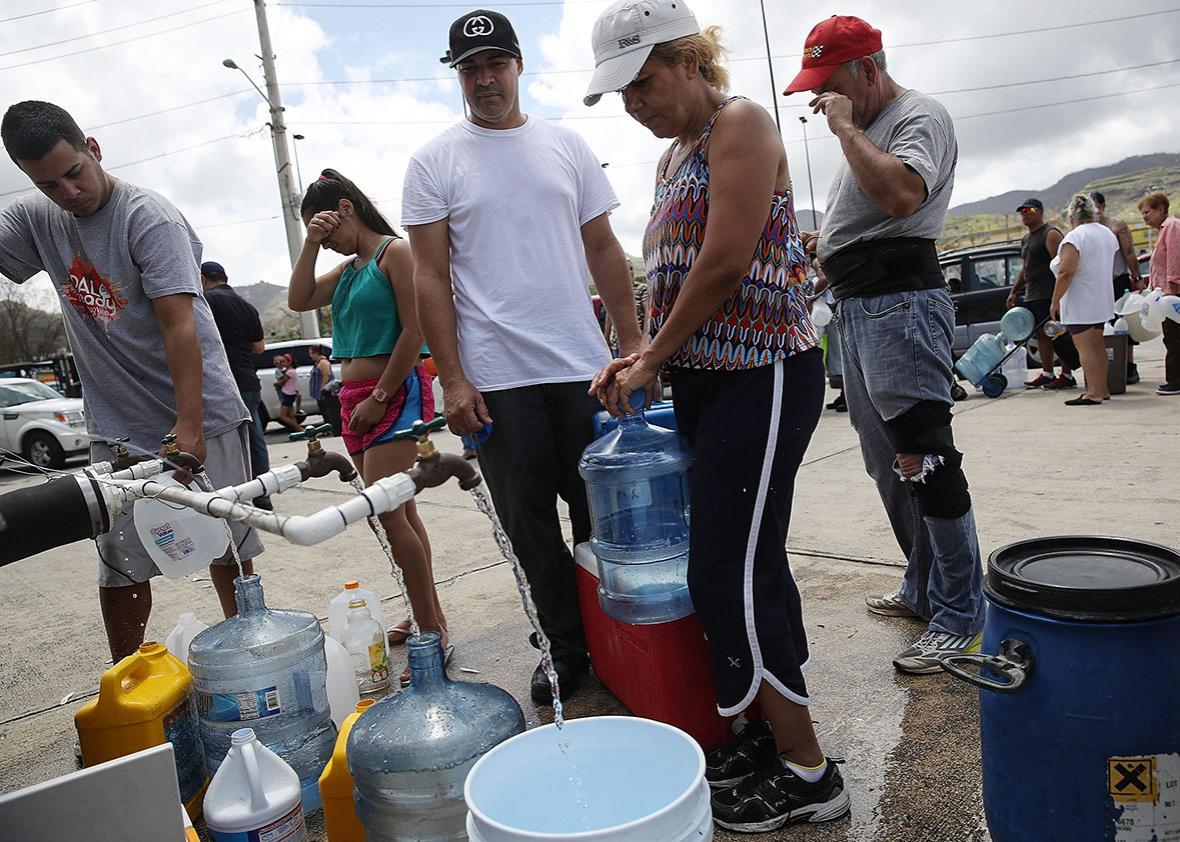Hurricane Maria slammed into Puerto Rico with Category 4 force last week, devastating the island nation and its 3.4 million residents. Despite an unusually active—and aggressive—hurricane season, Maria still managed to put up numbers. Its rainfall appears to have broken records, early estimates suggest the damage will exceed $30 billion, and at least 10 Puerto Ricans died. While a storm of this size would have wreaked havoc wherever it landed, it’s clear Maria’s “apocalyptic” nature was made worse by the already bleak situation in Puerto Rico, which has long suffered from decaying infrastructure and bankruptcy, and had already been hit by Hurricane Irma.
The storm made landfall on Wednesday, Sept. 20. It destroyed houses, blocked roads, and downed cell towers, making communication to family, friends, and relief workers spotty at best. For days now, residents have also grappled with dwindling supplies of food, water, and gasoline. Everyone on the island is without power as the entire grid was disabled by the storm. Power may not be restored for another six months. Hospitals with functioning generators are filling up.
But President Trump has not issued a statement—or a tweet—since the storm passed, something that did not go unnoticed in a weekend of otherwise bombastic tweets from the president. The perception of television news’ indifference to the crisis was also on people’s minds, as debates about the NFL protests and celebrity gossip drowned out the details of Hurricane Maria and its aftermath. While it is possible for people to focus on two problems at once, the relative silence about the storm led many to conclude that this indifference is perhaps not just a product of Trump but a larger problem with how America has always seen the island territory.
Still, help is on the way. As residents of an American territory, Puerto Ricans are American citizens, and that means they will receive support from the Federal Emergency Management Agency. Trump may have spent the weekend tweeting about football, but last Thursday he did declare that a major disaster had occurred there, which allows federal funds to be directed to the island. Several cargo ships of supplies having already arrived in Puerto Rico’s storm-battered ports. Private citizens like Jennifer Lopez are raising money and essentials like diapers for delivery.
Representatives of Puerto Rico have actually applauded the relief efforts, according to the Chicago Tribune:
[Puerto Rico Gov. Ricardo] Rossello and other officials praised the federal government for planning its response in detail before the storm hit, a contrast with what Puerto Rico has long seen as the neglect of 3.4 million Americans living in a territory without a vote in Congress or the electoral college.
“This is the first time we get this type of federal coordination,” said Resident [Commissioner] Jenniffer Gonzalez, Puerto Rico’s non-voting representative in Washington.
Disaster relief efforts have so far succeeded in part because of rather spooky timing: FEMA representatives were already in Puerto Rico when Maria struck in order to assess the damage wrought by Hurricane Irma. When Maria abated, those teams immediately began search-and-rescue efforts and started to recalculate the damage to the island from scratch. Since those emergency efforts, FEMA has also delivered freshwater and food, and plans are in place to deliver more and varied supplies, including satellite phones.
Still, it’s hard to imagine how the island, or its neighboring territory the U.S. Virgin Islands, will rebuild in the months and years to come. For one, Puerto Rico was already struggling to pay back its existing loans, let alone take on new ones for reconstruction. The federal aid that is on its way will be aimed at relieving the more temporary aspects of disaster.
The real trouble in Puerto Rico falls far outside what FEMA can provide. The New York Times reported that agriculture on the island, which feeds residents and is a major part of the Puerto Rican economy, has been completely destroyed. Experts think substantial farming efforts won’t return for another year. At the same time, the island’s infrastructure, which was already crumbling, has been dealt a deathly blow: The Guajataca Dam, which was built in 1929 and aims to keep water from submerging some 70,000 people, is cracked. And tourism, a large part of the economy of Puerto Rico and many other Caribbean nations also destroyed by recent hurricanes, is unlikely to return for the foreseeable future.
There are plenty of good reasons to worry about Puerto Rico right now. The situation there is, by all accounts, devastating. What is perhaps more frightening is the fact that remedying the island’s true needs will require months and years of dedicated attention—and by at least one measurement, we’re already falling down on the job.
